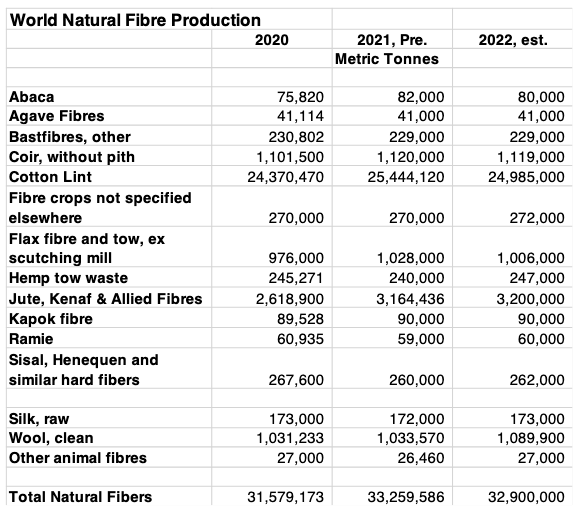World Natural Fibre Production in 2022 is estimated at 32.9 million tonnes, essentially unchanged from the estimate one month ago. Production reached 33.3 million tonnes 2021 and 31.6 million in 2020. The surging dollar and anxiety about a possible world recession leading to slumping demand are affecting commodity prices. Products made of natural fibres are largely discretionary purchases, and prices of natural fibres have historically been highly correlated withchanges in world GDP.
Nearby cotton futures on the Intercontinental Exchange plummeted 28% from the end of August to the end of September to $2.03 per kilogram. Cotton prices peaked at approximately $3.30 per kilogram in May 2022 and are now about 40% lower. However, prices remain above the ten-year average of approximately $1.75 per kilogram.
The Eastern Market Indicator of wool prices in Australia dropped 14% between mid- August and mid-September to US$8.11 per kilogram. The Australian dollar lost 6% of its value versus the US dollar during the month.
Prices of jute fibre in India quoted by the Jute Balers Association (JBA) at the end of August converted to US$ fell 1% from a month earlier to 78 cents per kilogram. Prices in rupee rose, but the exchange rate fell from 79.7 INR to the US dollar to 81.5.
Prices of silk in China equalled US$28.8 per kilogram at the end of September, compared with US$28.70 per kilogram at the end of August 2022. Prices in yuan rose 3% during the month, but a weaker exchange rate resulted in a negligible change measured in US dollars.
Coconut coir fibre in India held at US cents 21 per kilogram in September, with rising prices in rupee offset by a weaker exchange rate.
World cotton production is estimated at 25 million tonnes in 2022/23 (August to July), down 500,000 tonnes from the previous season. However, consumption is also declining, and stocks of cotton by the end of July 2023 are forecast to equal 9.5 months of use, compared to a long-run average of 6 months of stocks-to-use (https://ICAC.org).
World wool production is forecast up by 5% in 2022 to 1.09 million tonnes (clean), the highest since 2018. The wool market is divided between the fine wools used in apparel and broad wools used mainly in carpets and upholstery. The lack of demand for broad wool products in offices, hotels, airlines and public transport through the COVID pandemic has led to a divergence in prices,with broad wools now at historically low levels. (See also: Wool market report September 2022).
World production of jute and allied fibres is estimated by DNFI at 3.2 million tonnes in 2022, essentially unchanged from 2021. A relative shortage of higher-quality jute fibres is leading to a wider spread between prices of low-quality and high-quality fibre. The weakening Chinese yuan is contributing to weaker export demand. (See also: Jute market report September 2022 ).
Production of sisal and related fibres are estimated at 262,000 tonnes in 2022, essentially the same as in 2021. Exports of sisal fibres from Brazil slowed from almost 4,000 tonnes per month in May and June to 1,600 tonnes in August, primarily because of reduced purchases by Chinese customers. The depreciation of the Yuan versus the US dollar since April is contributing to the reduction in import demand.
The Woolmark Company is reminding consumers that an olympic swimming pool of crude oil is used every 25 seconds in the production of synthetic clothing, some of which ends up in landfills but most of which escapes into the wild at the end of use. Synthetic fibres stubbornly refuse to biodegrade, creating microplastic and other forms of pollution.

More About DNFI
The Discover Natural Fibres Initiative facilitates the exchange of information and experiences and works to advance the common interests of all natural fibres in the face of competition with oil- based and wood-based manmade fibres. Membership in DNFI is open to anyone with an interest in the growth of natural fibre industries.
Source
DNFI World Natural Fibre Update, press release, 2022-10.
Supplier
DNFI Discover Natural Fibres Initiative
The Woolmark Company
Share
Renewable Carbon News – Daily Newsletter
Subscribe to our daily email newsletter – the world's leading newsletter on renewable materials and chemicals










